The hanged, drawn, and quartered execution method was first devised in 13th-century England to punish men found guilty of high treason — and it was only abolished in 1870.

Public DomainMembers of the Gunpowder Plot who were hanged, drawn, and quartered in 1606.
In 1484, an Englishman named William Collingbourne was found guilty of high treason. His crime? Writing a couplet that insulted King Richard III and his top advisors. His sentence? Death. But not just any death — Collingbourne would be executed by being hanged, drawn, and quartered.
First, Collingbourne was dragged, or drawn, to his place of execution. He was hanged until he was nearly dead and then disemboweled. Still conscious, Collingbourne is said to have cried: “Oh Lord Jesus, yet more trouble!” as his intestines were thrown into a fire before his eyes. Then, the final stage of his execution took place when Collingbourne’s limbs were torn from his body.
This gruesome punishment was reserved for men found guilty of high treason, and it was used in England for centuries. Not only did it subject the victim to hours of grisly and painful torture, but it acted as a warning for others — such executions often drew crowds — to toe the line and respect the crown.
So, how did this horrific execution method begin? Who were some of the people who suffered death by being hanged, drawn, and quartered? And how did it finally end?
Hanged, Drawn, And Quartered: The Gruesome Punishment For Treason Against The Crown
Hanging, drawing, and quartering first emerged in the 13th century as a particularly torturous execution reserved for those guilty of treason. Though it was not codified into law until the 14th century, the method usually followed the same steps, subjecting the victim to hours of pain and humiliation.
British law informed the victim: “That you be drawn on a hurdle to the place of execution where you shall be hanged by the neck and being alive cut down, your privy members shall be cut off and your bowels taken out and burned before you, your head severed from your body and your body divided into four quarters to be disposed of at the King’s pleasure.”
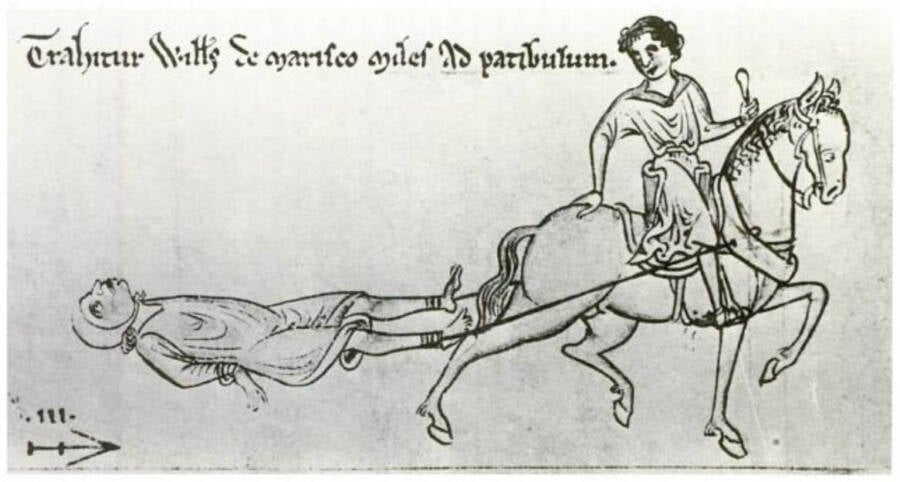
Public DomainA victim of hanging, drawing, and quartering being dragged to his execution.
It was thus broken into roughly three parts. First, the victim would be dragged to their execution, typically by a horse. Sometimes, they would be tied to a sled (a hurdle). Though this may seem merciful, it was only to ensure that they stayed alive. Some believe that this is the “drawn” part of the execution.
Next, the victim would be hanged — but not until they were dead, only until they lost consciousness. Then, they would be cut down, disemboweled, and castrated (some believe that this, not the dragging, is the “drawing” part). Often, their entrails would be burned before their eyes.
At this point, many people — the lucky ones — died from shock or other injury. Others were still alive until the moment they were beheaded. But being hanged, drawn, and quartered had one last step.
After the victims were dead (though some historical depictions of the execution method portray victims with their heads still attached for this step), they would be “quartered,” which meant that their bodies would be torn into four parts. Sometimes, they were simply chopped up by an executioner, but other times, their arms and legs would reportedly be tied to four different horses. The horses would then be spurred to race off in different directions, thus tearing the victim into four pieces.
These executions were usually held in public before huge, bloodthirsty crowds. However, to make sure the message reached anyone else tempted to defy the king, executioners would also display the victims’ body parts in public spaces like London Bridge.
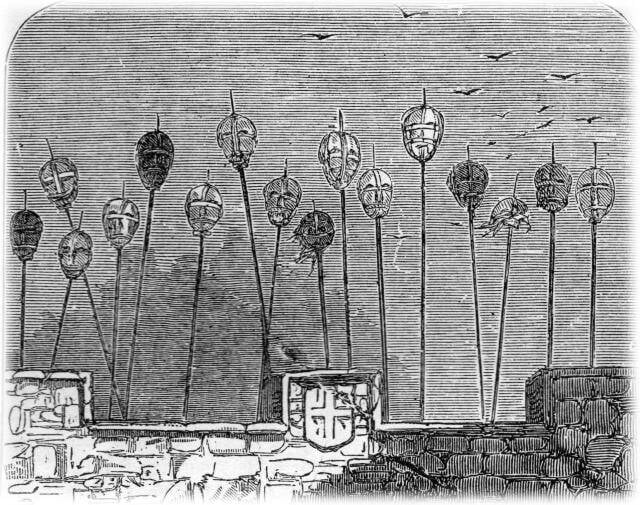
Public DomainThe heads of traitors displayed on London Bridge.
Indeed, from the 14th century on, being hanged, drawn, and quartered was not only a gruesome execution method — it was a popular one.
Men Who Were Hanged, Drawn, And Quartered Throughout History
Though there’s some debate over the original execution by hanging, drawing, and quartering, the first mention of the punishment came in the mid-13th century.
In 1238, a would-be assassin of King Henry III was condemned to death in a particularly violent way. According to Benedictine monk Matthew Paris’ English History, from 1235 to 1273, the man was “dragged asunder, then beheaded, and his body divided into three parts; each part was then dragged through one of the principal cities of England, and was afterwards hung on a gibbet used for robbers.”
A few years later, in 1241, a man named William Marise was found guilty of piracy. The son of a nobleman and the first person ever executed for piracy, Marise was condemned to be ripped into four pieces.
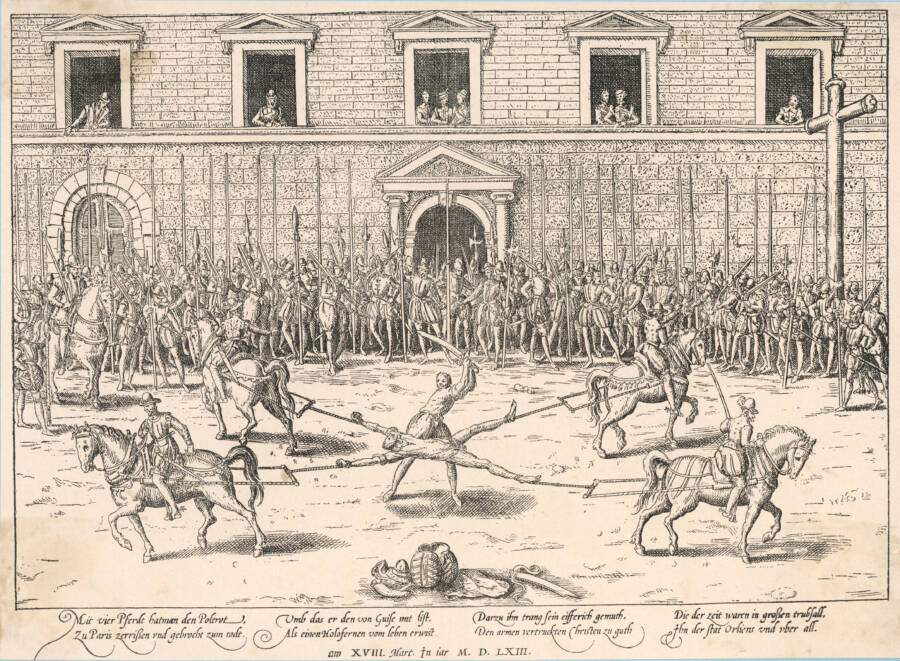
Chronicle / Alamy Stock PhotoA man being quartered. If they were lucky, the victims were already dead by this point.
From that point on, many more people were hanged, drawn, and quartered. Some of them were quite prominent. Take Dafydd ap Gruffydd, a Welsh prince who was sentenced to death for “compassing,” or imagining the death of the king. In 1283, he was drawn “as a traitor to the King,” hanged “as a murderer,” and quartered for “compass[ing] the death of his lord the King.” For good measure, the prince’s limbs were also burned for sacrilege.
But perhaps the best-known case of hanging, drawing, and quartering came two decades later with the execution of the Scottish knight William Wallace.
In 1305, Wallace was found guilty of treason for his role in the Scottish rebellion against England. He was condemned to die by hanging, drawing, and quartering. But William Wallace’s death was particularly brutal.
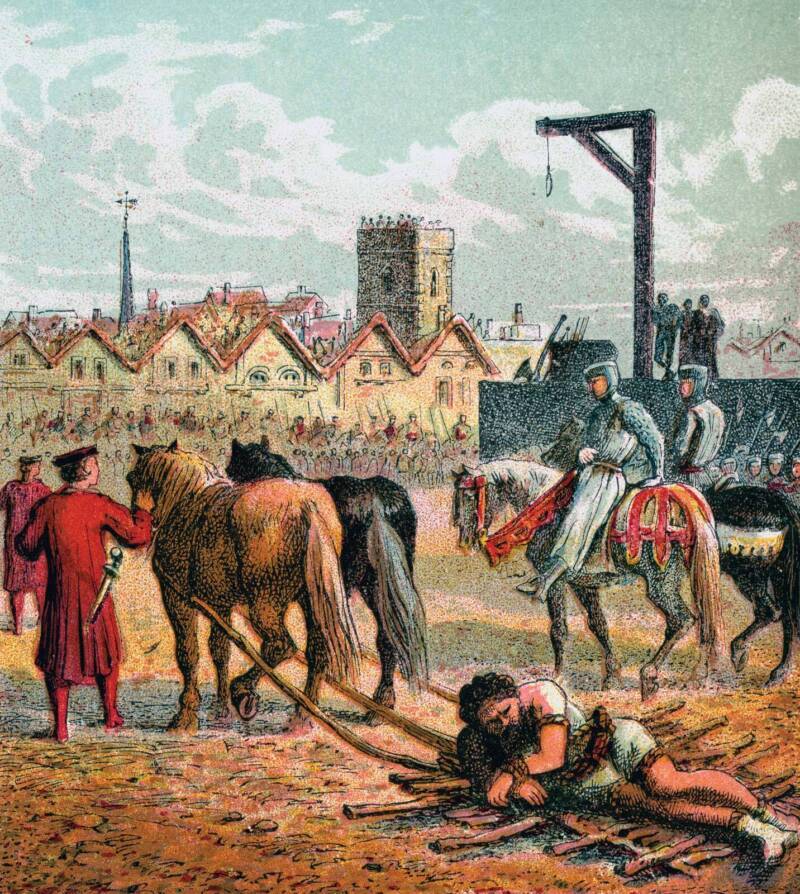
The Print Collector/Print Collector/Getty ImagesThe most famous case of being hanged, drawn, and quartered, William Wallace’s death was especially brutal.
The Scottish leader was stripped naked, tied to a hurdle, and dragged six miles to his place of execution as the jeering crowd threw trash and excrement at him. He was hanged but cut down while he was still alive. Wallace’s executioner chopped off his penis and testicles, cut out his intestines, and burned them all in front of Wallace. Wallace’s heart was then cut out, he was decapitated, and his body was cut into quarters. As if death had not been enough, Wallace’s body parts were then displayed throughout Britain — with his head stuck on a pike at London Bridge.
Wallace was far from the last person to die from being hanged, drawn, and quartered. Aside from Collingbourne, who met his grisly end in 1484, and Francis Dereham, who was killed in 1541 (for an alleged relationship with King Henry VIII’s wife Catherine Howard), many leaders of revolts were also executed this way, including the heads of the Peasants’ Revolt in 1381 and the men in charge of the Babington Plot against Queen Elizabeth I in 1586.
Guy Fawkes and his co-conspirators in the Gunpowder Plot were also condemned to die this way. However, Fawkes escaped the grisly fate when he leaped from the gallows ladder, breaking his neck. (His body was still quartered and put on display, however.)
So, how did the practice of hanging, drawing, and quartering end?
The End Of Hanging, Drawing, And Quartering In The 19th Century
Though hanging, drawing, and quartering may seem like a medieval execution method, it continued up until the 18th and 19th centuries. In 1798, Irish priest James Coigley became one of the last men killed this way in the 18th century for “compassing” the death of the king and supporting the French.
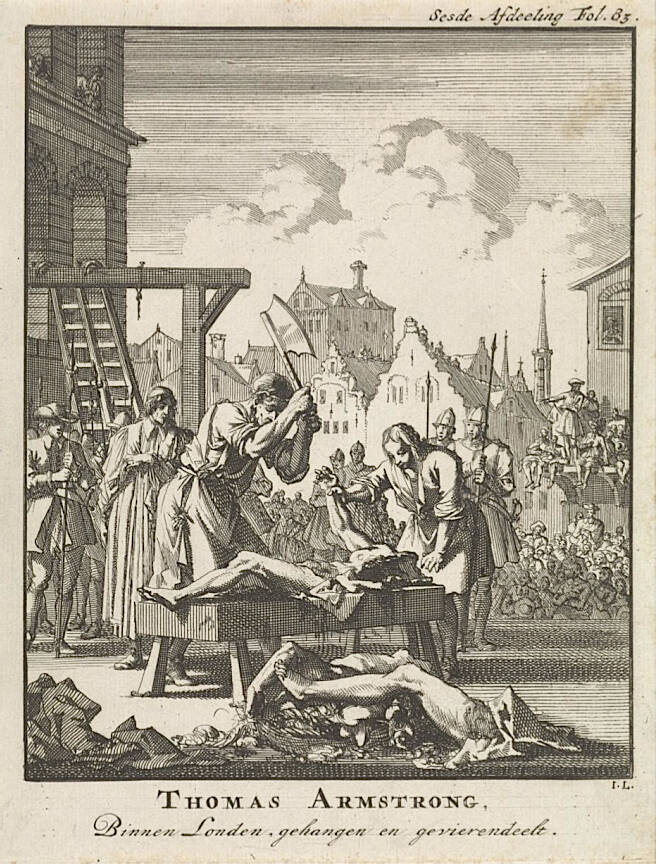
Public DomainThe 1684 execution of Thomas Armstrong, an English politician who was found guilty of treason and hanged, drawn, and quartered.
His condemnation ordered that: “the prisoner be taken from the bar to prison, and from thence to the place of execution; there to be hanged, but not until he be dead, to be cut down while yet alive, and then to have his heart and bowels taken out and burnt before his face; his head to be severed from his body; and his body to be divided into four quarters.”
In the 19th century, such executions continued, but victims were no longer disemboweled. Other parts of the execution became symbolic, as when Irishman Edward Marcus Despard and his six accomplices — sentenced to death for plotting to assassinate King George III — were symbolically “drawn” around the prison yard before they were hanged and decapitated.
From this point on, most of the condemned were hanged and decapitated (not drawn and quartered at all). And when the final sentence of hanging, drawing, and quartering was passed down in 1867, it was not carried out. Three years later, the Forfeiture Act of 1870 abolished the execution method.
Still, the history of hanging, drawing, and quartering left its mark. Not only did it make martyrs out of men like William Wallace, but it also showed just how cruel the human mind can be. For centuries, executing criminals wasn’t enough. The powers-that-be in England wanted to see their foes die in the most horrific, painful, and humiliating way possible — and, for hundreds and hundreds of years from the 14th century until the 19th century, they did.
After reading about the gory history of being hanged, drawn, and quartered, look through these gruesome medieval torture devices. Then, discover the story of the breaking wheel, one of the most horrific execution methods that mankind ever came up with.





